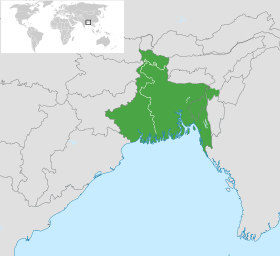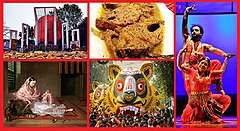Bangamata
Baṅgamātā (Bengali: বঙ্গমাতা), Mother Bengal or simply বাংলা/ Bangla, a personification of Bengal,[1][2][3][4][5] was created during the Bengali Renaissance and later adopted by the Bengali nationalists.[6][7][8][9] In Bangladeshi poetry, literature and patriotic song, she has become a symbol of Bangladesh, considered as a personification of the Republic. The Mother Bengal represents not only biological motherness but its attributed characteristics as well – protection, never ending love, consolation, care, the beginning and the end of life.

| Part of a series on |
| Bengalis |
|---|
 |
|
Bengali homeland |
|
Bengali culture
|
|
Bengali symbols |
Bankim Chandra Chattopadhyay, one of the greatest writer, poet and journalist of Bengal, composed an Ode to Mother Bengal (or Mother India, the text do not state) called Vande Mataram around 1876 as an alternative to the British royal anthem.[10]
In Amar Sonar Bangla, the national anthem of Bangladesh, Rabindranath Tagore used the word "Maa" (Mother) numerous times to refer to the motherland, i.e. Bengal. Despite her popularity in patriotic songs and poems, her physical representations and images are rare.
History
Partition of Bengal (1905)
During the period of বঙ্গভঙ্গ Bônggôbhônggô[11][12] (Partition of Bengal (1905)) - when the ruling British empire had the province of Bengal (of undivided India) split into two parts, many Bengali intellectuals joined cultural and political movement against the partition. The partition took place in October 1905 and separated the largely Muslim eastern areas from the largely Hindu western areas. The Hindus of West Bengal who dominated Bengal's business and rural life complained that the division would make them a minority in a province that would incorporate the Bihar and Orissa Province.[12] It was during this time the Mother Bengal was an immensely popular theme in Bengali patriotic songs and poems and was mentioned in several of them, such as the song ″Dhana Dhanya Pushpa Bhara″ and ″Banga Amar Janani Amar″ (Our Bengal Our Mother) by Dwijendralal Ray. These songs were meant to rekindle the unified spirit of Bengal, to raise public consciousness against the communal political divide.
Bangladesh Liberation War
Many of Bengali patriotic songs were regularly played on the Swadhin Bangla Betar Kendra, the clandestine radio station broadcast to revolutionaries and occupied population during the Bangladesh Liberation War.[13] some of these patriotic songs, such as “Jonmo Amar Dhonno Holo Maa-go” and “Bangla Moder Bangla Maa Amra Tomar Koti Shontan” have significant representations of “Mother Bengal”. She was an icon of freedom and democracy against all forms of dictatorship. These patriotic songs are still immensely popular in Bangladesh and West Bengal .
In art and literature
- Vande Mataram, by Bankim Chandra Chattopadhyay
- Banglar Mati Banglar Jol (poem), by Rabindranath Tagore
- Banga Amar Janani Amar, by Dwijendralal Ray
- Bangamata (poem), by Rabindranath Tagore
- Amar Sonar Bangla, by Rabindranath Tagore in 1905
- O Amar Desher Mati, by Rabindranath Tagore
- Bangladesh, by Kazi Nazrul Islam[14]
- Aaji Bangladesher Hridoy, by Rabindranath Tagore
- Bangla Mayer Kol, by Meera Dev Burman and S. D. Burman; better known by first line Takdum Takdum Bajai Bnagladesher Dhol[15][16]
- Oh Amar Bangla Maa, by Abul Umrah Fakhruddin and Alauddin Ali [17][18]
In his patriotic song, known as Aaji Bangladesher Hridoy (1905), the poet Rabindranath Tagore wrote the following depiction of Bangladesh:[19]
- When did you come out of the heart of Bangladesh,
- O, Mother dear, with such inexplicable splendor!
- It’s impossible to take away eyes from you!
- The doors of your golden temple have unlocked.
- Your right hand holds the blazing sword, the left one takes away fear,
- Smile of affection on the eyes, the third eye glaring.
- O Mother dear, how uniquely you reveal yourself!
- The cloud of your untied hair conceals thunders
- Ends of your sunlight coloured robes flutter in the horizon!
- It’s impossible to take away eyes from you!
- The doors of your golden temple have unlocked.
- When impassionately did not look up seemed
- Poor mother stayed back home , desolate, destitute.
- Your torn clothes vanish now, meager smile disappear.
- Beams of light scatter from your feet into entire sky
- O Mother, your appearance astounds me.
- You flood the world with the flow of happiness on the distressed nights
- O the mindblower, your word of fearlessness drum the heart
- It’s impossible to take away eyes from you!
- The doors of your golden temple have unlocked.
This is most probably only picturesque details of Mother Bengal.
See also
- National personification, contains the list of personifications for various nations and territories.
- Bharat Mata, the national personification of India as a mother goddess.
- Sri Lanka Matha, the national personification in the national anthem of Sri Lanka as a mother goddess.
- Siam Devadhiraj, the national personification of Thailand as a deity.
- Vande Mataram, song sung in reverence of Bharat Mata and Banga Mata.
- Joy Bangla
- Columbia, an equivalent symbol for United States of America.
References
- "Bharat Mata, more benign". The Indian Express. 15 June 2016.
- Singh, Amritjit; Iyer, Nalini; Gairola, Rahul K. (2016). Revisiting India's Partition: New Essays on Memory, Culture, and Politics. Lexington Books. ISBN 9781498531054.
- "Patriotic fervour". The Hindu.
- Bose, Sugata; Jalal, Ayesha (1998). Modern South Asia: History, Culture, Political Economy (1st ed.). Psychology Press. p. 121. ISBN 978-0-415-16952-3.
- Gupta, Swarupa (2009). Notions of Nationhood in Bengal: Perspectives on Samaj, c. 1867-1905. BRILL. ISBN 9789047429586.
- Dasgupta, Tapati (1993). Social Thought of Rabindranath Tagore: A Historical Analysis. Abhinav Publications. ISBN 9788170173021.
- Paranjape, Makarand (2014). Science, Spirituality and the Modernization of India. Anthem Press. ISBN 9781843317760.
- "Symbols of Water and Woman on Selected Examples of Modern Bengali Literature in the Context of Mythological Tradition". Archived from the original on 12 December 2013. Retrieved 12 December 2013.
- "Thinking Allowed: Feeling seditious or patriotic?". Deccan Chronicle (Opinion). 21 March 2016. Retrieved 30 October 2016.
- Sri Aurobindo commented on his English translation of the poem, "It is difficult to translate the National Anthem of Bengal into verse in another language owing to its unique union of sweetness, simple directness and high poetic force." Quoted in Bhabatosh Chatterjee (ed.), Bankim Chandra Chatterjee: Essays in Perspective, Sahitya Akademi, Delhi, 1994, p. 601.
- John R. McLane, "The Decision to Partition Bengal in 1905," Indian Economic and Social History Review, July 1965, 2#3, pp 221–237
- "Partition of Bengal". Encyclopædia Britannica. Retrieved 18 August 2017.
- Syed Badrul Ahsan (1 December 2012). "1971 and the songs we sang". The Daily Star. Retrieved 13 December 2013.
- "বাংলাদেশ". 9 June 2014.
- https://www.jiosaavn.com/lyrics/ami-takdum-takdum-bajai-lyrics/GQlbSRx8DkY
- https://www.thedailystar.net/shout/echoes/the-voice-the-bhati-regions-bangladesh-163636
- https://www.songtexte.com/songtext/jagoroner-gaan/o-amar-bangla-ma-tor-335fc041.html
- https://www.thedailystar.net/shout/echoes/alauddin-ali-the-king-melody-191506
- "Lyric aaji bangladesher hridoy". geetabitan.com. Archived from the original on 17 October 2012.